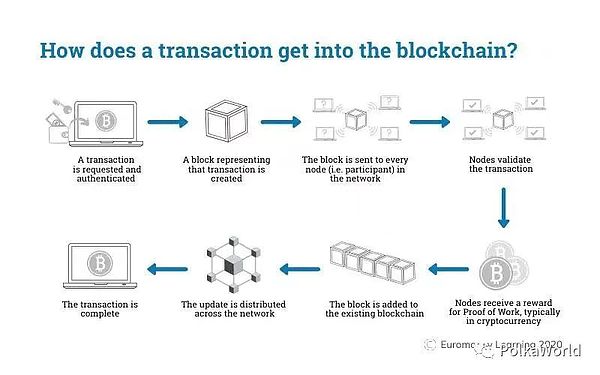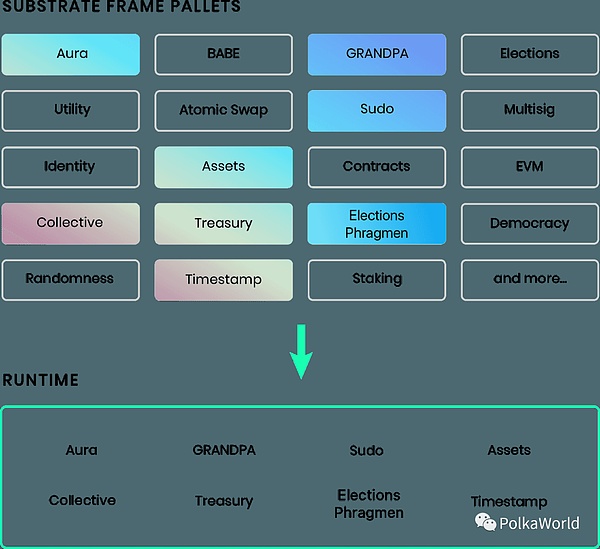Author: PolkaWorld
The launch of Celestia has attracted a lot of attention from the industry and also led to the craze of "modular blockchain". Recently, NEAR Blockchain also announced that it will launch the NEAR DA data availability layer and enter the field of modular blockchain.
So what exactly is the recently emerged “modular blockchain”? Is Polkadot a modular blockchain? What's the difference between the two?
What are “modular blockchains” like Celestia?
The "modular blockchain" we discuss here refers to Celestia, Avail, EigenDA, etc., modular blockchains in the context of the Ethereum ecosystem.
The concept corresponding to "modular blockchain" is "single blockchain".
The core responsibilities of blockchain are generally divided into four parts:
Execution: Supports the execution of transactions and enables deployment and interaction with smart contracts.
Data availability: Ensure the availability of transaction data.
Consensus: The content and sequence of approved transactions.
Settlement: Used to complete transactions, resolve disputes, verify proofs, and bridge different execution layers.
In a single blockchain , these responsibilities are all completed by one chain. For example, Bitcoin and Ethereum are representatives of single blockchains. But this brings a problem, which is poor scalability and high cost.

Transaction process on a single chain, source: Euromoney
As a result, the concept of modular blockchain emerged. Its core idea is to separate different responsibilities and outsource them to specialized independent layers (modules), thereby making the main chain more scalable and cheaper.

Comparison of monolithic blockchain and modular blockchain, source: Celestia
For example, ZK Rollup and Optimistic Rollup outsource the execution layer, while Celestia and Avail outsource the data availability (DA) layer.
In addition to external solutions, Ethereum itself is actually seeking to improve scalability through Proto-Danksharding technology (EIP-4844).
To sum up, in the context of the Ethereum ecosystem, "modular blockchain" is a technical solution born to improve the scalability of Ethereum. It separates the execution layer and data availability layer of the blockchain into different "modules".
Is Polkadot a modular blockchain?
We often hear the concept of "modular blockchain" in Polkadot, but this is not the same as the modularity mentioned above.
Polkadot is a heterogeneous multi-chain system, consisting of a relay chain and multiple heterogeneous parallel chains. The relay chain is responsible for maintaining the consensus and security of the entire network, while the parachains can focus on their respective applications and performance. Cross-chain data transmission and interoperability can be achieved between parallel chains through XCM.

Polkadot architecture, source: mercuryo
Therefore, Polkadot can achieve horizontal scalability , that is, as the number of parachains increases, the throughput of the network also increases. The asynchronous support technology being developed can further improve scalability, allowing Polkadot's parachain block generation time to reach 6 seconds, and can support thousands of parachains.
In other words, Polkadot’s multi-chain (or sharding) architecture has largely solved the scalability bottleneck, which is why we rarely discuss Rollup, DA layer, etc. to improve scalability in the Polkadot ecosystem. Sexual program reasons.
But Polkadot is indeed the pioneer of modular blockchain.
Polkadot’s architecture is modular
From the above description, it is not difficult to see that Polkadot’s architecture itself embodies the idea of modularity .
The relay chain is responsible for security and consensus. Each parachain can focus on building its own areas of expertise. For example, the KILT parachain focuses on identity, and the HydraDX parachain focuses on DEX. Each parachain is actually a module. Parachains in the ecosystem can interact with other parachains by sending cross-chain messages (XCM) to use the functions provided by other parachains (modules).
Polkadot is also working on a "minimized relay" plan, stripping off some functions of the relay chain and delegating them to multiple "system parallel chains", thereby reducing the burden on the relay chain and allowing the relay chain to better focus on for consensus and security. At present, Polkadot has put the functions of assets and collectives on the chain into the system parallel chain. In the future, it will also put governance, pledge, transfer and other functions into the system parallel chain. Here, each system parallel chain is a "module" in a blockchain, and minimizing relays is to improve the scalability of the Polkadot blockchain through modularity.
Modular blockchain development framework: Substrate
Polkadot's Substrate framework is a modular open source framework for developing blockchains. It provides highly flexible and customizable modules, allowing developers to design the operating logic of the blockchain according to their own needs.
The modules in Substrate are called Pallets , and they are some predefined functional modules. Therefore, Substrate is like a "blockchain Lego" that allows developers to use existing modules to quickly build a blockchain that meets their own needs, greatly lowering the threshold for blockchain development. Developers can also develop their own Pallet to facilitate rapid integration with other chains.
The following figure lists some Pallets included in the Substrate framework:

Substrate Pallets (modules), source: Substrate documentation
There are more Pallets that provide various rich functions, and the number of Pallets is also increasing. You can view the latest Pallets here: https://docs.substrate.io/reference/frame-pallets/.
Recently, Parity merged Substrate with the Polkadot and Cumulus code bases to form the Polkadot SDK. Polkadot SDK is a blockchain software development toolkit for developing the Polkadot network. It allows developers to easily create their own parachains, thereby enabling innovation and customization of the blockchain.
So is it possible for Polkadot to launch a DA layer?
Theoretically, Polkadot can also decouple data availability and provide it separately as a DA layer, thereby expanding a larger market. However, this requires joint discussion and decision by the Polkadot community and developers. Some community members have already had a heated discussion on this in the Polkadot forum:
https://forum.polkadot.network/t/polkadot-da-vs-competition/3403/26.
In addition, you can also take advantage of the modular development of Polkadot SDK to develop a data availability blockchain. In fact, some people are already doing this. Polygon's data availability blockchain Avail project was developed using Polkadot's Substrate framework and uses the same GRANDMA + BABE consensus as Polkadot.
Summarize
Modular blockchain is a technical solution that separates different responsibilities of the blockchain and assigns them to specialized independent modules. It is an important direction in the evolution of blockchain technology.
In the Ethereum ecosystem, modular blockchains are mainly proposed to address the scalability issues of Ethereum, such as Celestia, Avail, etc.
In the Polkadot ecosystem, modular blockchain is the essential feature of Polkadot. Polkadot’s multi-chain architecture and modular development framework Substrate enable blockchain innovation and customization.






